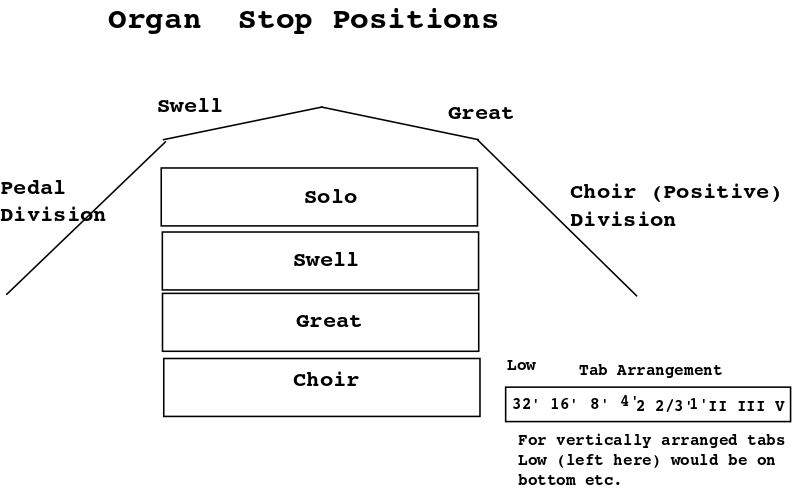
| 4´ Clarion | |
| 16´ Trombone | 8´ Trumpet |
| 2´ Fifteenth | V Mixture |
| 4´ Principal | 2-2/3´ Twelfth |
| 8´ Dulciana | 4´ Harmonic Flute |
| 8´ Open Diapason | 8´ Stopped Diapason |
| 16´ Double Open Diapason | |
| Gt Super Octave | Gt Sub Octave |
| Swell to Great | Choir to Great |
| Tonality | Tab Colour | Engraving colour |
|---|---|---|
| Diapason | Off White | Black |
| Diapason Celeste | Off White | Red |
| Open Flute | Ivory | Black |
| Stopped Flute | Ivory | Brown |
| Flute Celeste | Ivory | Red |
| String | Blue | White |
| String Celeste | Blue | Red |
| Tibia | Grey | White |
| Chorus Reeds | Black | White |
| Orchestral Reeds | Red | White |
| Tonal Percussion | 'Moddled' Yellow | Black |
| Atonal Traps | 'Moddled Yellow | Red (originally White) |
| Midi & Electrophone | Green | White |
| Function | Stop Colour | Engraving colour |
|---|---|---|
| Octave & Sub-octave Couplers | Blue | White |
| Unison Coupler | White | Black |
| Unison Off | Red | White |
| Pizzicato Coupler | Yellow | Black |
| Harmonic Coupler | Yellow | Black |
| Division Transfer | Green | White |
| Mute | Red | White |
| 4´ Clarion | |
| 16´ Trombone | 8´ Trumpet |
| 2´ Fifteenth | V Mixture |
| 4´ Principal | 2 2/3´ Twelfth |
| 8´ Dulciana | 4´ Harmonic Flute |
| 8´ Open Diapason | 8´ Stopped Diapason |
| 16´ Double Open Diapason | |
| Gt Super Octave | Gt Sub Octave |
| Swell to Great | Choir to Great |

| 2 Manual | 3 Manual: | 4 Manual: | 5 Manual: | |
| V | Echo | |||
| IV | Solo | Solo | ||
| III | Swell | Swell | Swell | |
| II | Swell | Great | Great | Great |
| I | Great | Choir | Choir | Choir |


